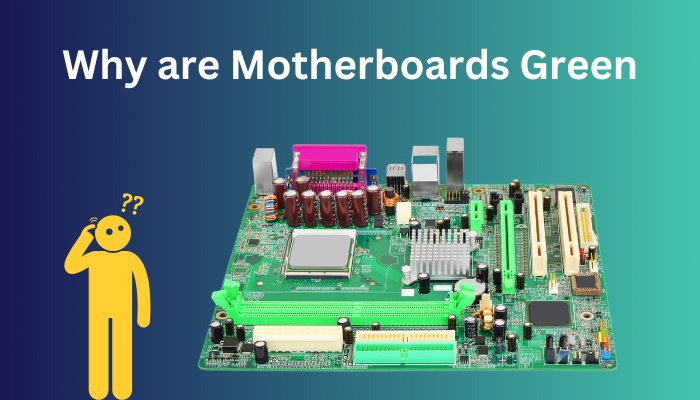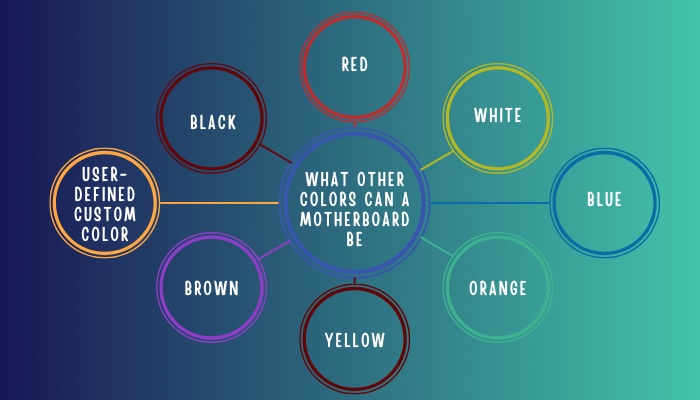Close your eyes & imagine a motherboard. Chances are, you pictured a flat green board with little dots, traces & output plugs. But why green? Why, out of all colors, do PCB manufacturers use green as the standard color?
The above question is not only asked by many enthusiasts but also questioned by anyone who has ever worked on any PCB or electronic circuit boards or at least noticed it.
So let’s unravel this mystery now, shall we?
Why are Motherboards Green?
Motherboards are green due to the solder mask applied on top of the PCB. The motherboard itself isn’t green. It’s the green-dyed layer of protective coating that gives the motherboard its appearance. This layer protects the motherboard’s copper traces from degrading over time.
To be honest, we need to modify the question asked initially because it’s an inaccurate inference. It’s the resin applied atop the PCB that is dyed green.
The motherboards/PCBs are comprised of several ultra-thin copper layers. Since copper oxidizes over time with the help of water vapor from the atmosphere, a protective sealant is needed to prevent the degradation of traces & signals over time.
This sealant is called solder mask & consists of non-conductive plastics & resins with dyes that are typically green. So back to the question, why green?
Well, you can find many supposed reasons on the world wide web, but there’s no specific reason why green is the color of choice for so many printed circuit boards.
Follow our guide to fix BIOS is updating LED firmware on Asus Motherboards.
When computers first became popular, motherboards were printed in various colors but green became the standard with time.
Perhaps the most common reason I found was human psychology & easiness of the green color on our eyes. For instance, researchers have discovered that human eyes are more sensitive to green light.
Green is also known to reduce eye strain so employees can inspect PCBs without getting their eyes tired.
Other reasons include its ability to identify different types of computer components, cost-effectiveness, traceability etc.

Here are the reasons why motherboards are green:
Easy on the Eye
Colors like bright yellow can act as stimulants & induce anxiety, while colors like violet or blue can be physically difficult to perceive. Electricians & engineers who stare at PCBs 24/7 would appreciate a color that doesn’t evoke unwanted irritation.
Since green is a generally pleasing color, most manufacturers have chosen it for their motherboard/PCB color.
Quickly check our epic post on how to fix a new Graphics Card showing black screen.
Aid in Inspection
Now you can say that if the human eye’s easiness is the main factor, why not use a lighter shade of yellow or blue?
Well, they don’t always contrast nicely with the copper traces, which are the small copper paths connecting two or more points on the PCB.
To QC boards in production, copper tracks need to be apparent. Bare copper is already golden orange-ish color & would contrast poorly with a light yellow shade of resin. Same for light blue.
Colors that do contrast greatly with copper are red & green. This is why these two motherboard colors are the most prevalent. This ties in with the previous point of human psychology. Red is a much more aggressive color & not very pleasant to look at for look duration.
So green is the only color left that contrasts nicely with copper traces & is easier for the inspection process.
Cost-effective
The green dyes were comparatively low-priced & readily available. So manufacturers who are intended to mass produce motherboards/PCBs choose the cost-effective green color to save cash on big-scale production.
Solder masks are applied using a process called silkscreen printing. Here, if you want another solder mask color, it involves removing the excess solder mask oil before applying the new color, which adds cost.
For white or lighter solder mask shades, more cost is added since you will require another station for the black silkscreen ink. In addition, unused colors may waste chemicals.
Better Solder Mask Dams
These are vital for ICs and fine-pitch components. Green solder mask is the only color that can reliably produce 0.1mm (4mil) solder mask dams. Other colors can only make solder mask dams of 0.12mm and 0.15mm.
Therefore, the green color favors all these important factors. As a result, it has become one of the most common color pallets for the motherboard/PCB solder mask.
Interested in discovering what’s inside a motherboard? Read our detailed article to find out what motherboards are made of.
What Other Colors Can a Motherboard Be?
As clear computer cases and tempered glass windows are growing in popularity, the inner layouts of desktop PCs are no longer hidden from the viewers.
This has prompted many manufacturers to offer many colors for their motherboard/PCB and this has resulted in white motherboards and blue motherboards for a unique appearance. The blue and yellow color are quite popular among enthusiasts.
In most cases, different colors are often used by manufacturers for a prototype.

Here are some alternate colors of motherboards:
- Black.
- Red.
- White.
- Blue.
- Orange.
- Yellow.
- Brown.
- User-defined custom color.
Black motherboards are probably the 2nd most commonly used color on the market, after green motherboards, as it matches any desktop aesthetic.
Go and check our other article on can I use two different brands of RAM.
Does the Color of a Motherboard Matter?
The color of the motherboard does not matter. The solder mask’s color doesn’t affect the motherboard’s performance at all. Applying a black solder mask instead of green won’t make any difference other than the visual aesthetic.
The mask coating only helps to insulate & protect the copper traces from any degradation or short circuit. Other than this, it doesn’t have any impact from a consumer standpoint.
If you are looking for a way to protect your motherboard, you should look into a motherboard cover, instead of colors.
Although, if you are trying to make a custom PC build & want to match all the components in a tempered glass casing, then the color of the motherboard would matter. You can even customize the color of your PC’s motherboard by investing a bit more cash.
Can You Pick Your Own Motherboard Color?
Yes, you can pick your own motherboard color, as long as money isn’t an issue. There are several printed circuit board companies that offer you various options for PCB colors. You can choose electronic boards that are already printed in different colors, or build a custom one.
Are you wondering why motherboards have steep price tags? Find out why motherboards are expensive in just two minutes by reading this article.
When building a motherboard, many people often want to pick their own color for it. While this may not seem possible, there are options available.
Solder mask colors are the colors that are seen on the surface of the board and can be changed to any color desired.
Whether you want to match your components, have an aesthetically pleasing look or just choose a specific color, these come in many different varieties including exotic colors. Yellow is one effective color in the exotic category.
While the color green became the traditional industry standard for decades as a pigment, you can choose to distinguish different PCB’s by using unique colors.
With so many different colors to choose from, you can easily find one that fits your motherboard build perfectly. Pick something subtle or go all out with flashy and exotic colors and make sure your build stands out from the crowd!
Why Does A Motherboard Need A Solder Mask?
A motherboard needs a solder mask to insulate and protect it from unexpected damage. In order to do this, a special polymer material called the solder mask is used. This is a hardened resin used to protect electronic traces of copper from oxidation to prevent short circuits.
Computer motherboards are an integral part of any computer, and the soldering process is essential for connecting components. During this process, it is normal for excess solder to be applied to the motherboard which can cause solder bridges that can create short circuits and damage the board.
This is precisely why a solder mask is necessary. The solder mask oils help spread the material evenly across the board, forming an even layer that covers all exposed areas.
This helps prevent any solder bridges from forming, protecting the board from damage. Without a solder mask, computers would be a lot more unreliable and prone to failure due to short circuits caused by excess solder on the motherboard.
Apart from this, silkscreen printing on an electronic board requires a solder mask.
Frequently Asked Questions
What is a motherboard?
A motherboard is the central component of computers or other digital devices. It houses all the critical components, and tiny circuits & allows communication between them.
Does the color of a motherboard indicate its quality?
No. A motherboard’s color doesn’t indicate the quality of the motherboard.
Why do Asus ROG laptops use red motherboards?
It’s the manufacturer’s choice. Asus use red motherboards in their ROG laptops instead of the standard green color because it matches their gaming aesthetics.
Conclusion
The main reason why motherboards were initially manufactured in green was due to the cost-effectiveness of the green dye. Black-colored motherboards are currently more favored as they match the aesthetic of most desktop PCs.
I hope this write-up has provided all the answers & explanations that you were looking for. If you have any further queries, feel free to share your thoughts in the comment section below.



